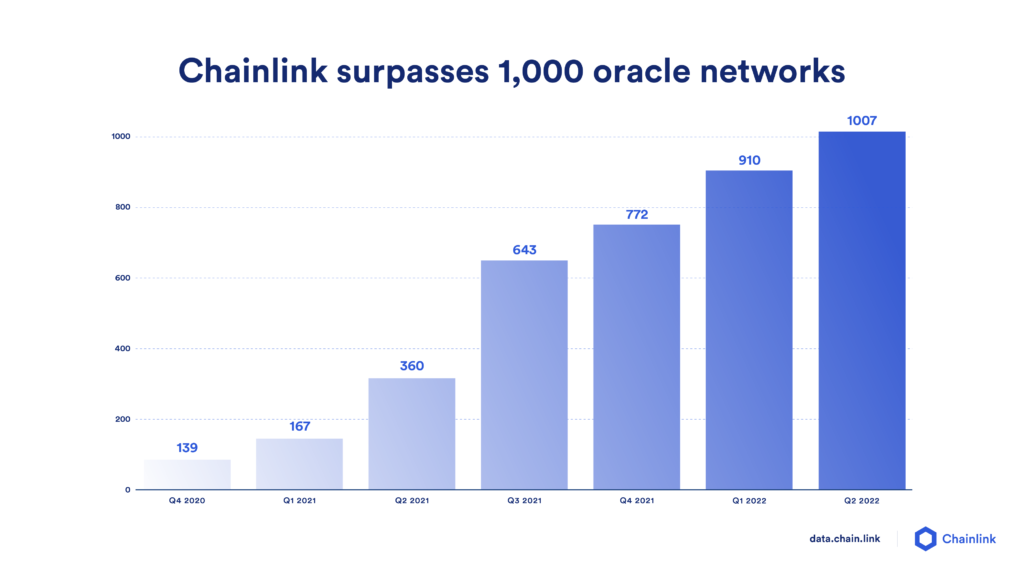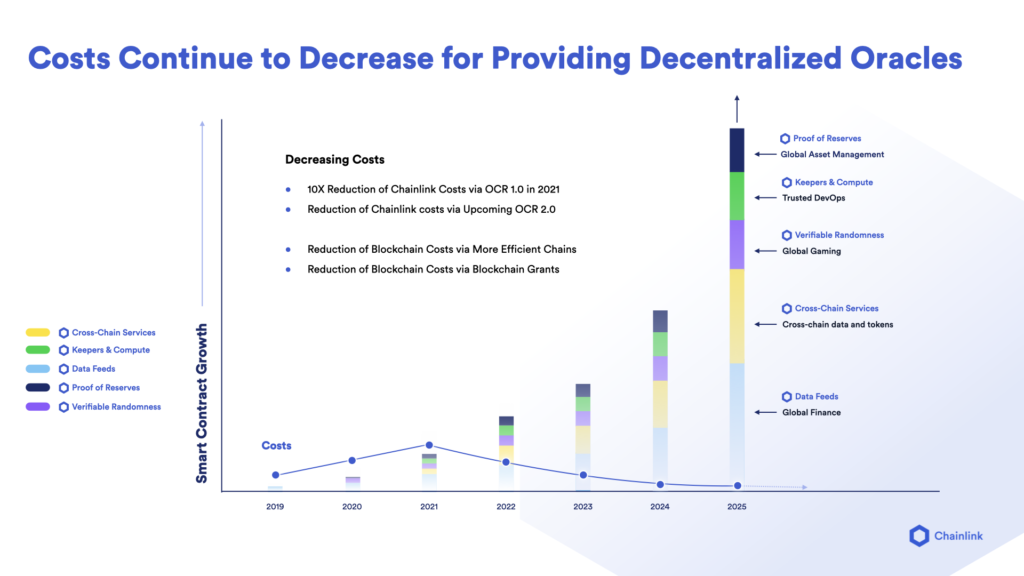Increasing the Cost Efficiency of Decentralized Oracle Networks
The virtuous cycle of Chainlink’s economic model involves both generating revenue by meeting the demand for secure oracle services and by continually reducing the costs of providing these oracle services on-chain. This post, based on Chainlink Co-founder Sergey Nazarov’s presentation on Chainlink Economics 2.0, will explore these two dynamics by highlighting the growing demand for oracle services supported by the Chainlink Network and the ongoing initiatives to reduce the operating costs of decentralized oracle networks for the benefit of the greater Web3 ecosystem.
The Growing Demand for Oracle Services
High-Quality Off-Chain Data
The initial goal of the Chainlink Network was to pioneer a form of consensus that generated aggregations of key datasets. Market data has been the first category where Chainlink is now seen as a standard and widely credited with expanding the world of DeFi. The widespread adoption of Chainlink Data Feeds is a result of the network’s expansive and time-tested configuration of nodes, as well as high-quality data sources. A multitude of data providers and data sources beyond market data have also appeared in the Chainlink Network, including weather events, sports outcomes, business financials, and more, and are being used by various decentralized applications for parametric insurance, on-chain gaming, dynamic NFTs, and more.
Secure Off-Chain Computation
Beyond reliable data aggregation and delivery, the Chainlink Network has seen growing demand for secure off-chain computation, including decentralized smart contract execution via Chainlink Automation and verifiable random number generation via Chainlink VRF. This demand enables continual improvement of the Chainlink protocol and the services it supports, such as Chainlink VRF v2, a more scalable and gas-efficient source of on-chain randomness, which has seen an uptick in usage since its launch earlier this year.
Evolving Capabilities of Chainlink: Expandable Computation and Cross-Chain Communication
The capabilities of Chainlink oracle networks are continuing to expand to support more and more advanced computation, from putting smart contract operations into an Automation network, to more novel parts of the protocol like DECO, which allows certain privacy-sensitive computations to be performed in oracle networks, to Fair Sequencing Services (FSS) for decentralized transaction ordering, to the Cross-Chain Interoperability Protocol (CCIP).
From market data to random number generation to more sophisticated off-chain computation, Chainlink is widely used and recognized as the most secure standard for oracle computation. The growing capabilities of the Chainlink protocol, such as cross-chain communication, continue the pattern of enabling more and more advanced smart contract use cases and contributing to the virtuous cycle of oracle networks providing the key infrastructure to support more advanced trust-minimized applications. This ultimately creates a greater collective consciousness of trust-minimized applications as an option, and therefore, a greater market for them.

Reducing the Costs of Chainlink Oracle Networks
Beyond the virtuous cycle of oracle network adoption and innovation, Chainlink oracle services are starting to witness an economy of scale and a continuing decline in costs due to several key factors.
Technical Innovations
The costs for providing decentralized oracle network services peaked last year after the release of the Off-Chain Reporting protocol (OCR). The Chainlink Network saw a 10x reduction in the cost to operate various oracle networks on-chain, while also seeing a huge explosion in the amount of decentralized oracle networks, which went from the low hundreds to soon crossing a thousand distinct networks. Through oracle scalability improvements such as OCR and VRF v2, the Chainlink Network has continually seen a decline in the cost of providing everything from market data on-chain to verifiable randomness and other categories of computation.

Blockchain Cost Efficiency and Scalability Improvements
The reduction in oracle network costs has also been driven by the increasing efficiency of blockchains themselves. One of the key properties that all blockchains are competing with each other on—whether they’re more established blockchains or new networks—is scalability and the cost of transactions. This competition has already led more and more Chainlink oracle networks to become profitable on cost-efficient blockchains like Polygon and BNB Chain.

Fast Lanes and Blockchains Providing Grants
There are two additional dynamics within blockchain ecosystems that can continue to reduce oracle costs even more.
One is the idea of introducing a fast lane or a specific part of a blockchain protocol for transactions related to oracles as a public good. Fast lanes are a more technical solution to reducing the costs of oracle networks so that they can provide greater and greater amounts of value to developer ecosystems in larger volumes at lower costs.
The second dynamic involves multiple blockchains providing grants to eliminate the costs of putting oracle requests on-chain. Mutualizing the costs of native oracle access greatly benefits the blockchain environments by providing them a massive influx of high-quality data and other key oracle network services and allowing them to attract and grow a developer ecosystem.
Turning Oracle Networks Into a Public Good
This wide range of cost reductions—from the technical optimizations within the Chainlink protocol itself, to the increasing scalability of blockchains, to blockchain initiatives to eliminate the cost of oracle reports on-chain—help to establish oracle networks as a shared public good for the benefit of developers and dApp teams across Web3.
This increasingly efficient model is fundamental to Chainlink Economics 2.0 and aimed at providing a sustainable oracle infrastructure to power the trust-minimization market, which is poised to become the largest technology market in the world.
To learn more about Chainlink Economics 2.0, explore more Economics 2.0 posts on the Chainlink blog and read the FAQ of Chainlink’s economic model. This post is based on Sergey Nazarov’s presentation, Chainlink Economics 2.0 and the Market for Trust-Minimized Applications, which was published on June 10, 2022.
